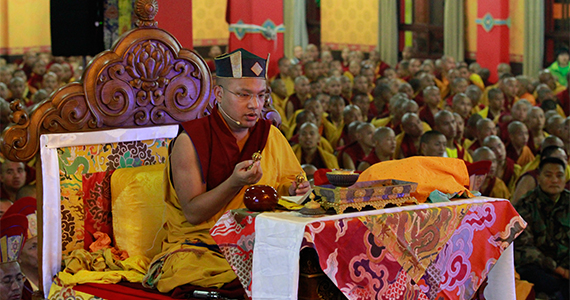5 December 2013 – Tergar Monastery, Bodhgaya
On the anniversary of the parinirvana of the great First Karmapa, Dusum Khyenpa, His Holiness the Seventeenth Karmapa led several special celebratory events in the holy place of Bodhgaya.
After continuing the scheduled Kagyu Gunchö program in the morning, in the afternoon the Gyalwang Karmapa gave a detailed teaching on the sacred spiritual biography or namthar of Dusum Khyenpa, followed in the evening by a special Feast Offering Puja.
The great master known as Dusum Khyenpa, or ‘the knower of the three times’, was renowned for his ability to clearly see the past, present and future. He was the wellspring of the Karma Kamtsang lineage, and the first in the string of lives of the seventeen Karmapas, following one after another like beads on a mala.
Teaching to a gompa packed full with monks, nuns and a growing crowd of international students, the Gyalwang Karmapa began by observing that only recently have people begun to give greater importance to the anniversary of Dusum Khyenpa’s passing. “In the tantras it is said that we should pay attention to special dates and the special moments in great masters’ lives,” he began, “because our positive actions on these days are multiplied many times and we can accumulate great merit.”
He then explained that great masters of the past have said that their core instructions are actually their spiritual biographies. “When masters would tell their life stories it’s not just their words or teachings, but their own lived experience of putting the dharma into practice. Their life stories are living instructions,” he said. “Therefore Dusum Khyenpa’s biography is something to keep in your heart.”
The Gyalwang Karmapa described how, long before his eventual birth, Dusum Khyenpa’s coming was predicted in many sutras and tantras, such as the Samadhiraja Sutra. His life-story is filled with miraculous feats of spiritual accomplishment and signs of his high degree of realization, beginning right from when he was still in his mother’s womb.
“One day his pregnant mother Lhathok was working in the fields when she heard a voice from her belly, saying, ‘Please go home, I’m going to take birth soon’,” the Gyalwang Karmapa related. “Hearing that voice she went home very quickly to give birth to Dusum Khyenpa. Those fields are still there in Tibet today, called the ‘fields where a voice came from’.”
The Gyalwang Karmapa then told how as a child Dusum Khyenpa became famous for other miraculous feats such as creating springs, leaving handprints and footprints in many boulders, subduing a demon at the age of 8, and making rain fall during a very dry summer at the age of 9. At the age of 11 Dusum Khyenpa was able to pacify conflict throughout the region using extraordinary tantric means. It was at the age of 16 when Dusum Khyenpa ordained as a novice monk that he first came to possess the famous black crown that is now synonymous with the Karmapas.
“In the historical accounts, at that time Dusum Khyenpa had a pure vision in which 100,000 dakinis appeared and placed the black crown on his head,” the Gyalwang Karmapa explained. “Together they empowered him as the ‘doer of the activities of all the Buddhas’, and gave him the name Karmapa. In some of the biographies it’s said that all those who were present even saw this vision.”
The Gyalwang Karmapa also commented that according to some historical sources, the black crown symbolizes the inseparability of Dusum Khyenpa and the great Indian Mahasiddha Saraha.
The Gyalwang Karmapa then related how throughout his life Dusum Khyenpa was known by a series of different names, including Khampa Usay, or ‘the yellow-haired Khampa’.
“Since he was a child he was blond,” the Gyalwang Karmapa said, “and his face was just like the face of a monkey.” He told the story of how in a previous life Dusum Khyenpa had insulted a monk, telling him his face looked like a monkey. With this one act, the Gyalwang Karmapa explained, he created the karma to be reborn with monkey features himself for many lifetimes, and Dusum Khyenpa was the last of these monkey-faced lives.
Throughout his long life Dusum Khyenpa spent many years meditating in remote caves, under the guidance of his root guru Gampopa, and attained many signs of realization. He also founded the three monasteries which became his main seats in Tibet, Kampo Nenang, Karma, and Tsurphu.
“It was due to the power of Dusum Khyenpa’s strong prayers and aspirations that the Karma Kamtsang lineage first appeared,” the Gyalwang Karmapa told those gathered—a lineage which flourishes to this day, over 900 years on.
After completing his detailed two-hour teaching on Dusum Khyenpa’s spiritual biography, around 7pm the gompa once again started to fill as the crowd assembled for a special ‘Dusum Khyenpa Feast Offering’ puja. By 7.30pm the gompa was full, with people spilling out onto the surrounding balconies in the cool early winter night, all eager to take part.
The Gyalwang Karmapa first offered three prostrations before an exquisite thangka of Dusum Khyenpa surrounded by the Kagyu lineage masters. He then took his seat on a throne facing the elaborate altar, filled with precious offering substances and tormas.
On the anniversary of Dusum Khyenpa’s parinirvana those gathered were gifted with the rare treat of the Seventeenth Karmapa personally leading a two-and-a-half hour puja as Umze or Chantmaster. The Gyalwang Karmapa’s voice rose and fell with the melodies, carrying the blessings of the Karmapa lineage, and became a bridge that momentarily connected all those present with the mindstream of Dusum Khyenpa.
Under the spell of the transformative power of his presence, the puja became imbued with an extra layer of the sacred, and as the Gyalwang Karmapa personally led hundreds of monks, nuns and laypeople through the chants the blessings of all seventeen Karmapa incarnations rained down.











